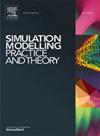Driving simulator validation studies: A systematic review
IF 3.5
2区 计算机科学
Q2 COMPUTER SCIENCE, INTERDISCIPLINARY APPLICATIONS
引用次数: 0
Abstract
Driving simulators (DS) serve as pivotal platforms for the rigorous testing of transportation systems and vehicles, offering a safe, controllable experimental environment with features like design visualization, scenario virtualization, and test data quantification. The validation of simulator experiments relies on the realism of the driving experience and scenario fidelity, crucial for assessing data reliability and result credibility. With the advent of autonomous driving technologies, the frequency of DS utilization has seen a marked expansion. Nonetheless, the discourse surrounding DS validation remains nascent, lacking a consolidated framework of standards and evaluative methodologies. This review endeavors to synthesize existing scholarly discourse and reports on the validation of driving simulators, further probing into the suitability of various driving scenarios and tasks. Common scenarios include car-following, lane-changing, and acceleration/deceleration, while tasks encompass human-machine co-piloting, takeover scenarios, and emergency evasion, considering driver conditions such as fatigue and distraction. Extracting universal indicators from various scenarios, including longitudinal and lateral velocities, accelerations, and trajectories, the paper summarizes the experimental workflow and commonly used statistical testing methods and psychophysiological monitoring devices for driving simulator validation. Considering the multidimensional factors influencing validation, this study discusses the relationships between simulation fidelity, degrees of freedom (DOF), and simulator sickness, proposing reference standards for driving simulator validation. This effort aims to advance the establishment of evaluation norms for simulation-based transportation and vehicle research, ensuring scientific rigor and empirical validity.
驾驶模拟器验证研究:系统回顾
驾驶模拟器(DS)是对运输系统和车辆进行严格测试的关键平台,它提供了一个安全、可控的实验环境,具有设计可视化、场景虚拟化和测试数据量化等功能。模拟器实验的验证依赖于驾驶体验的真实性和场景的保真度,这对于评估数据可靠性和结果可信度至关重要。随着自动驾驶技术的出现,模拟器的使用频率明显增加。然而,围绕自动驾驶系统验证的讨论仍处于起步阶段,缺乏标准和评估方法的综合框架。本综述试图综合现有关于驾驶模拟器验证的学术论述和报告,进一步探究各种驾驶场景和任务的适用性。常见的场景包括跟车、变道和加速/减速,而任务则包括人机协同驾驶、接管场景和紧急避险,并考虑到驾驶员的疲劳和分心等情况。本文从各种场景中提取通用指标,包括纵向和横向速度、加速度和轨迹,总结了用于驾驶模拟器验证的实验工作流程、常用统计测试方法和心理生理监测设备。考虑到影响验证的多维因素,本研究讨论了模拟保真度、自由度(DOF)和模拟器病态之间的关系,提出了驾驶模拟器验证的参考标准。这项工作旨在推动建立基于模拟的交通和车辆研究的评估规范,确保科学的严谨性和经验的有效性。
本文章由计算机程序翻译,如有差异,请以英文原文为准。
求助全文
约1分钟内获得全文
求助全文
来源期刊

Simulation Modelling Practice and Theory
工程技术-计算机:跨学科应用
CiteScore
9.80
自引率
4.80%
发文量
142
审稿时长
21 days
期刊介绍:
The journal Simulation Modelling Practice and Theory provides a forum for original, high-quality papers dealing with any aspect of systems simulation and modelling.
The journal aims at being a reference and a powerful tool to all those professionally active and/or interested in the methods and applications of simulation. Submitted papers will be peer reviewed and must significantly contribute to modelling and simulation in general or use modelling and simulation in application areas.
Paper submission is solicited on:
• theoretical aspects of modelling and simulation including formal modelling, model-checking, random number generators, sensitivity analysis, variance reduction techniques, experimental design, meta-modelling, methods and algorithms for validation and verification, selection and comparison procedures etc.;
• methodology and application of modelling and simulation in any area, including computer systems, networks, real-time and embedded systems, mobile and intelligent agents, manufacturing and transportation systems, management, engineering, biomedical engineering, economics, ecology and environment, education, transaction handling, etc.;
• simulation languages and environments including those, specific to distributed computing, grid computing, high performance computers or computer networks, etc.;
• distributed and real-time simulation, simulation interoperability;
• tools for high performance computing simulation, including dedicated architectures and parallel computing.
 求助内容:
求助内容: 应助结果提醒方式:
应助结果提醒方式:


